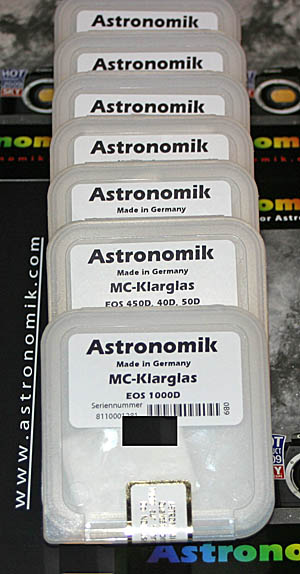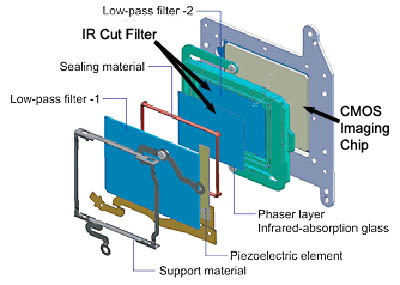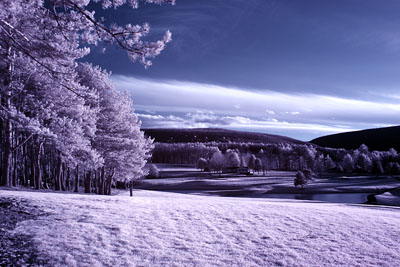 Astronomik Clear Glass Modification for Canon DSLRs
Astronomik Clear Glass Modification for Canon DSLRsThe Full Spectrum modification is available for the Canon models listed HERE.
After extensive testing, the Astronomik DSLR Clear Glass replacement has been found to provide a perfect solution for conversion of Canon DSLR models to “Full Spectrum” imaging capability. A Full Spectrum modification converts a DSLR camera for both astro-imaging and daytime infrared photography. The camera’s autofocus feature and optical viewfinder will continue to work as in the original un-modified camera. A full spectrum conversion with the high quality Astronomik optically polished mulit-coated clear glass eliminates blocking of Ultraviolet (UV) and Infrared (IR) light from the CMOS imaging chip. The camera can then be used to image all wavelengths of light from UV to visible to IR by selecting appropriate external filters. External filters for many applications are now widely available as screw-on camera lens filters, 2″ filters and other sizes available for CCD astro imaging devices and also as clip-in filters that can be placed inside the camera body.
Experienced astrophotographers, Eric Vesting and Gerd Neumann, founders of Astronomik have brought this new exciting innovation to market for DSLR astro imagers, along with Astronomik’s reputation for the highest quality filter standards at reasonable prices for the amateur astronomer.
Imaging possible with a Full Spectrum modification:
1. Astro Imaging: A Full Spectrum modified camera can be used for astro imaging, without any external filters, if the telescope system being used is “reflector” based and contains no lenses. Mirror systems focus all wavelengths of light to the same point; the lenses in refractor telescopes do not. Even the highest quality APO refractors usually require the use of an IR block filter to block infrared wavelengths that do not focus at the same point as visible light. Adding an external UV/IR filter to the optical train, such as the Astronomik UV/IR clip-in filter or Astronomik Luminance (IR/UV) – 2″ Mounted or the Baader 2″ UV/IR filter among others, can be used for astro imaging with optical systems that do include lenses. Clip-in filters can be used with Canon camera lenses as long as they are not the EF-S type. Clip-in light pollution filters have become very popular with those imaging in areas of light pollution. An ultraviolet pass filter can be used with a Full Spectrum camera to image cloud features on Venus and Jupiter. Other specialized filters such as the Astronomik Planet IR Pro 807 Filter can be used for enhanced lunar and planetary imaging. Simple spectroscopy of bright stars can be done with a Full Spectrum DSLR camera.
Example – M42:
2. Normal (terrestrial) Photography: A Full Spectrum modified camera can be used for normal imaging, as before modification by adding an external color correcting filter. A color correcting filter returns any modified camera to its original state of color balance and sharp focus because it restores the camera to the original transmission characteristics of the pre-modified camera. One such filter is the Astronomik OWB (Original White Balance) Filter, available in many sizes, including a clip-in version available from me:
http://www.astronomik.com/en/photographic-filters/owb-ccd-filter.html
I sell a 58mm lens thread-on UV/IR and also a 58mm Color Correcting filter.
A Full Spectrum camera, without adding an external color correcting filter, can be used with the Canon DSLR’s “Custom White Balance” (CWB) feature to get the color balance close, and even closer using image processing software, but since infrared light is not being blocked, images will not be as sharp as with the non-modified camera. That is why use of a color correcting filter is preferred.
Another option for color correction is to use a UV/IR filter. If an external UV/IR filter such as the Astronomik UV/IR clip-in filter is used with the Full Spectrum camera, the Canon DSLR’s “Custom White Balance” (CWB) feature can be used correct color balance for normal daytime photography. Contact me if you need the filter.
3. Infrared Photography: A Full Spectrum modified camera can be used for infrared photography by adding an external infrared pass filter such as the popular Hoya R72. The part of the spectrum seen by the imaging chip is referred to as near-infrared as opposed to far-infrared. An infrared filter allows infrared (IR) light to pass through to the imaging chip while blocking all or most of the visible light spectrum. The resulting infrared images have a “dreamlike” appearance in which blue sky is very dark, atmospheric haze disappears, vegetation such as trees and grass glow brightly and eyes appear black. Post-processing techniques such as false color processing are quite often used for displaying the infrared images. Non-modified cameras or those modified instead with the Baader UV/IR filter are not capable of producing infrared images of the same quality because infrared light is blocked inside the camera.
Astronomik’s complete line of filters for astro imaging can be seen HERE. All Astronomik filter transmission curves are HERE.
The DSLR clear glass replacement is based on Astronomik’s popular “Astronomik MC-Clear” filter as detailed HERE.
Transmission Curve for the Astronomik MC-Clear filter can be seen HERE.
The clear glass replacement is optically polished and multi-coated to maximize transmission and avoid ghosting. Both original Canon filters, Low-pass filter #1 and Low-pass filter #2, as shown below are removed from the camera and the single Astronomik clear glass is placed in the Low-pass filter #1 position.

Since the original filter with the piezoelectric cleaning element is removed, the “auto sensor cleaning” function of the camera is disabled. The “manual sensor cleaning” function can still be used to clean the replacement Astronomik clear glass. With the Full Spectrum modification, the CMOS imaging chip is still protected from dust by the installed Astronomik MC Clear Glass replacement
The Astronomik clear filter replacement does not by itself return the modified camera to correct Auto Focus operation without adjusting the position of the CMOS imaging chip assembly. During camera modification, measurement is made of the existing shims or torx screws used by Canon, calculations are made for making replacement shims or adjusting the torx screws in order to maintain correct autofocus operation. A detailed procedure for modifying the Canon DSLR models begins HERE.


